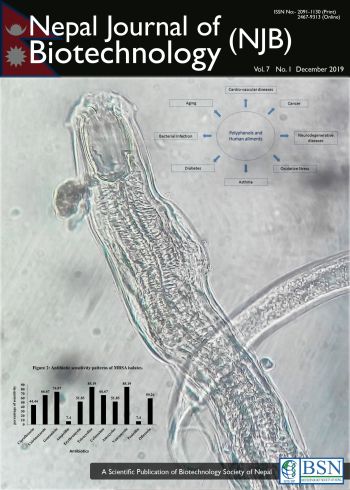Infectious sources of Histoplasmosis and molecular techniques for its identification
DOI:
https://doi.org/10.3126/njb.v7i1.26949Keywords:
Histoplasmosis, asymptomatic, vulnerable, treatmentAbstract
Histoplasmosis, a fungal infection caused by Histoplasma capsulatum (H. capsulatum), acquired from contaminated soil with droppings of chicken or birds and found to be distributed in many parts of the world. The prevalence of histoplasmosis has not well studied in Nepal. The common symptoms of acute and epidemic histoplasmosis include high fever, cough, and asthenia and weight loss. Most of the infections associated with histoplasmosis are asymptomatic. People with compromised immune systems such as HIV/AIDS (PLWHA), cancer, and organ transplant recipients are at risk of developing this disease. In this review, we have summarised the current status of histoplasmosis in Nepal and molecular techniques available for its identification. To date, the significant outbreak is not reported in Nepal, but the risk of infection for the vulnerable population cannot be undermined. Appropriate preventive measures and treatment on time can reduce the burden of this fungal disease. Further, this review is also focused on molecular identification of H. capsulatum. Hence, careful considerations by concerned stakeholders for national surveillance programs and the treatment of patients on time after proper diagnosis is highly recommended.
Downloads
Downloads
Published
How to Cite
Issue
Section
License
Copyright Notice:
The manuscript submitted to NJB must be an original contribution, not previously published and should not be under consideration for publication elsewhere. When the manuscript is accepted for publication, the authors agree to automatically transfer the copyright of the article to the publisher. It should grant permission to any third party, in advance and in perpetuity, the right to use, reproduce or disseminate your article, according to the NJB copyright and license agreement.
Authors transfer copyright to the publisher as part of a journal publishing agreement but have the rights to: Share their article for Personal Use, Internal Institutional Use and Scholarly Sharing purposes, with the NJB applies the Creative Commons Attribution-NonCommercial CC BY-NC license to all the works we publish after Jun 2020 (Before it was CC BY-NC-ND). Under this license, authors agree to make articles legally available for reuse, without permission or fees, for virtually any non-commercial purpose. Anyone may remix, adapt, and build upon your work non-commercially, and although their new works must also acknowledge you and be non-commercial, they don’t have to license their derivative works on the same terms. More details on CC BY-NC refer to its Licence Deed and Legal Code.






